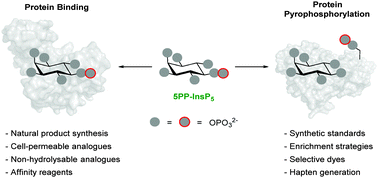Chemical tools for interrogating inositol pyrophosphate structure and function
Abstract
The inositol pyrophosphates (PP-InsPs) are a unique group of intracellular messengers that represent some of the most highly phosphorylated molecules in nature. Genetic perturbation of the PP-InsP biosynthetic network indicates a central role for these metabolites in maintaining cellular energy homeostasis and in controlling signal transduction networks. However, despite their discovery over two decades ago, elucidating their physiologically relevant isomers, the biochemical pathways connecting these molecules to their associated phenotypes, and their modes of signal transduction has often been stymied by technical challenges. Many of the advances in understanding these molecules to date have been facilitated by the total synthesis of the various PP-InsP isomers and by the development of new methods that are capable of identifying their downstream signalling partners. Chemical tools have also been developed to distinguish between the proposed PP-InsP signal transduction mechanisms: protein binding, and a covalent modification of proteins termed protein pyrophosphorylation. In this article, we review these recent developments, discuss how they have helped to illuminate PP-InsP structure and function, and highlight opportunities for future discovery.

- This article is part of the themed collection: 2016 Emerging Investigators

 Please wait while we load your content...
Please wait while we load your content...